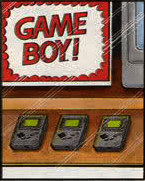This is an old revision of the document!
Table of Contents
Game Boy
 The little handheld that could. Nintendo's Game Boy (and family) had, pretty much, a monopoly on the handheld market until the PSP showed up. Its first challengers, the Game Gear and Lynx, tried to out muscle it with more power and colour screens, while later competitors like the Neo Geo Pocket and WonderSwan mimicked its basic capabilities, but didn't get a chance to match its library. It held them all off with a diverse range of software. Or maybe just Pokémon.
The little handheld that could. Nintendo's Game Boy (and family) had, pretty much, a monopoly on the handheld market until the PSP showed up. Its first challengers, the Game Gear and Lynx, tried to out muscle it with more power and colour screens, while later competitors like the Neo Geo Pocket and WonderSwan mimicked its basic capabilities, but didn't get a chance to match its library. It held them all off with a diverse range of software. Or maybe just Pokémon.
There have also been some interesting hardware revisions and curious peripherals as is typical of any hardware with a long life and large user base.
Personality
Audio
Visual
The Game Boy's visual style is largely defined by its 'four shades of grey'. Throughout its life careless developers struggles to make readable games as they sought to match what the 16-bit systems were doing (see: Rare, license game developers).
The first hardware version, the 'brick', was more green than grey, and busy games tended to get blurry in motion. So these graphic quirks also influenced the system's library. The Game Boy Pockets had nicer, and greyer, screens, which had less or no motion blur and were a little less particular about light conditions.
Design
Library
Periphera
Adaptors for other hardware
Bits of hardware used to play Game Boy games on other systems.
Gameboy Booster / GB Hunter
Not-so-good adaptor for playing GB games on Nintendo 64.
- Gameboy Booster & GB Hunter on Chris Covell's Homepage.
Super Game Boy
Super Game Boy 2
Wide Boy
Wide-Boy64
Allows playing GB and GBC games on the Nintendo 64
- Wide-Boy64 on Chris Covell's Homepage.
See also
- The Decline of the Game Boy in Numbers - Article by Chris Covell analysing software released.
- Game Boy mono games with unexpected link-cable multiplayer - SB forum thread.